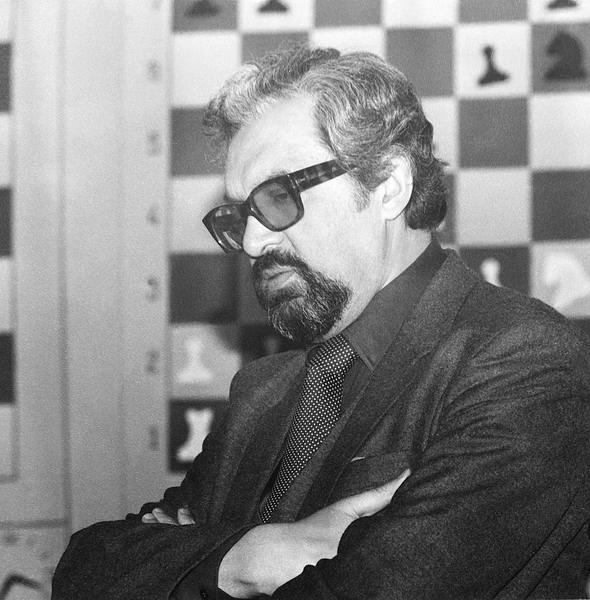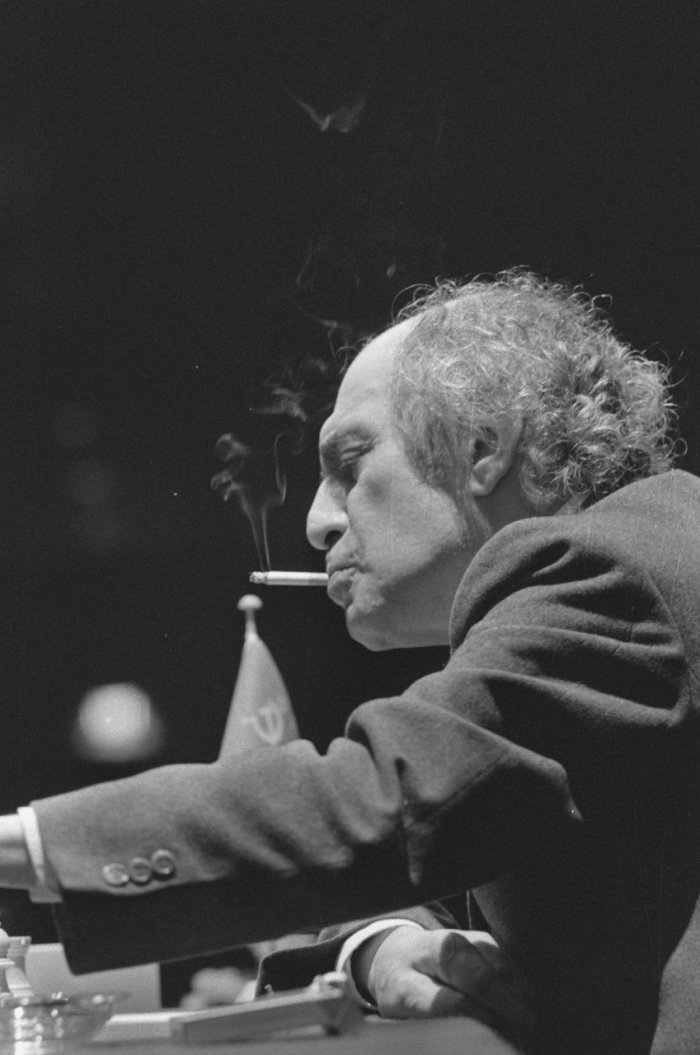In the course of three years in the second half of the 1980s, Mikhail Tal twice had occasion to play six-game matches against the leading Dutch grandmaster Jan Timman. In both cases his second Vladimir Bagirov annotated the match-games for the Soviet Latvian magazine Shakhmaty (Riga). This blog post features translations of these annotations, plus some brief background to each match.

Jan Timman and Mikhail Tal shake hands prior to the last game of their 1988 match in Hilversum. (Photo credit: R. Croes / ANEFO, via the Dutch National Archive.)
VLADIMIR BAGIROV
Vladimir Bagirov (b. 1936) – a famous trainer and theoretician as well as a strong grandmaster – was a native of Baku, and his name was associated with that city for much of his career. By the late 1970s he was, it seems, increasingly unsatisfied with his living arrangements in Azerbaijan, and despite appeals to authority, no change was apparently forthcoming. It was apparently thanks to the intervention of Tal that a large, comfortable apartment was found for him in the Latvian capital, and so in 1979 Bagirov exchanged the shores of the Caspian for those of the Baltic. Thus, by the mid-1980s Tal and Bagirov had been working together for several years, and Bagirov was a regular second of the ex-World Champion at important events.

Vladimir Bagirov, pictured in the 1980s. (Photo from the archive of ‘64‘.)
MONTPELLIER 1985
During October & November 1985, the FIDE Candidates’ tournament took place in the southern French city of Montpellier. The first three places were shared by Artur Jussupov, Andrei Sokolov and Rafael Vaganian. 4th-5th spot was shared by Jan Timman and Mikhail Tal. Under the regulations of that cycle, only four players would go through to a series of Candidates matches that would ultimately determine the challenger for the World Championship. Thus, Timman and Tal faced each other in a six-game playoff match to determine who the fourth qualifier would be. Originally the match was scheduled to take place immediately after the Candidates’ tournament, but it was delayed for a month so that Tal could participate in the World Team Championship in Luzern. According to the late Mark Dvoretsky, this suited both participants:
Neither player wanted to play [immediately]. First, they were tired; they had just played 15 games. Second, they would not get paid for the match in Montpellier, and delaying it would give Timman an opportunity to find a sponsor for a prize fund.
Timman’s coefficient from the tournament in Montpellier was better than Tal’s, so that he effectively had ‘draw odds’ in the match. Not surprisingly, Vladimir Bagirov expressed some dissatisfaction with this. In his introduction to his report on the match, he states:
Unfortunately, one point in the regulations was unfavourable for the Rigan. As opposed to the majority of previous analogous cases, when after a drawn result at least two additional games were envisaged, this time there would come into play the system of coefficients (according to the results in Montpellier). Moreover, not the usual Berger, but some new one, taking account only of the results of those opponents scoring more than 50%. According to such an index, Timman had the advantage.
Tal had the white pieces in the 1st game, which proved to be a short but entertaining draw in a sharp variation of the English Opening. The 2nd game also proved to be a short affair – Tal was crushed in only 27 moves after Timman sprung an opening novelty in a well-known position of the Queen’s Gambit Accepted. After two fairly uneventful draws in the 3rd and 4th games (an Open Spanish and an Old Indian Defence, respectively) Timman needed only one more draw to secure the sought-after qualifying place.
The 5th game was undoubtedly Tal’s best in the match. In a French Defence, play passed from the opening directly into rook-and-bishop endgame in which White had a pawn less, but his king, remarkably, was able to advance into the heart of Black’s position. Timman found a satisfactory way to return the pawn, forcing the exchange of bishops and reaching a rook endgame that was clearly drawn with best play. However, suffering from nerves, he missed two clear ways to steer the game to safety, and Tal took full advantage to level the score in the match.
And so to the decisive 6th game. In a relatively rare variation of the Sicilian Schevenginen, Tal came up with a new idea for Black, and achieved a clear advantage straight out of the opening. However, he failed to capitalise and, running short of time, let Timman back into the game. The Dutch grandmaster defended accurately and despite Tal’s desperate attempt to keep the game going with an exchange sacrifice, the game ended in a draw after the adjournment.
Thus, Timman progressed to the Candidates’ Quarter-final match v. Artur Jussupow, which took place in January 1986 in the Dutch town of Tilburg.
As Bagirov comments in his annotations, the match was noteable on two accounts – for the diversity of opening choices (the six games saw six entirely different openings), and for the number of pawn sacrifices played by both players. Translations of his notes can be downloaded at the following links:
Tal-Timman, 1st match-game, Montpellier Candidates’ playoff, 1985
Timman-Tal, 2nd match-game, Montpellier Candidates’ playoff, 1985
Tal-Timman, 3rd match-game, Montpellier Candidates’ playoff, 1985
Timman-Tal, 4th match-game, Montpellier Candidates’ playoff, 1985
Tal-Timman, 5th match-game, Montpellier Candidates’ playoff, 1985
Timman-Tal, 6th match-game, Montpellier Candidates’ playoff, 1985
HILVERSUM 1988
In December of 1988 Jan Timman faced Mikhail Tal in what was the seventh in a series of annual matches in the town of Hilversum, sponsored by the local broadcasting company KRO. In previous years the Dutch grandmaster had faced Korchnoi, Spassky, Portisch, Kasparov, Jussupow and Ljubojević. These matches had all made for entertaining chess, and the 1988 edition proved to be no exception.
As in their 1985 duel, Tal had the white pieces in the opening game. He made little impression on Timman’s Slav Defence, had to play carefully to draw the endgame. The 2nd game was a magnificent affair, the finest game of the match. In the main line of the Botvinnik System of the Semi-Slav Defence, Timman resurrected an old variation, forcing Tal to think hard at the board. Tal became short of time, and went wrong at a critical point in the middlegame, though it took some exceptionally fine play by Timman to capitalise on this. Many outstandingly beautiful variations remained ‘behind the scenes’, and were only found many years later when Timman was preparing notes to this game for his book Timman’s Titans. (I have incorporated these variations to the notes by Bagirov.) Thus, as in 1985, Timman had taken an early lead.
The 3rd game – a Queen’s Indian Defence – saw a quiet draw. However, Tal struck back in the 4th, gaining a crushing victory with the Black pieces in a Sicilian Scheveningen. Worse was to come for Timman the next day. Tal employed an opening novelty as early as the 5th move in a well-known position from the English Opening. (Bagirov relates that the idea had come up in discussion while the pair were in mid-air on their way to Amsterdam; he humorously suggested that it should therefore be known as the ‘Aeroflot Variation’.) Tal gained a big advantage in a queenless middlegame, and though his play was rather unconvincing at times, he took the full point to go ahead in the match with one game remaining. A quiet opening in the 6th game (another Slav Defence) led to simplification and a somewhat anti-climactic draw.
Thus, victory in the match went to Tal, by the score 3½:2½.
Translations of Bagirov’s annotations can be downloaded at the following links.
Tal-Timman, 1st match-game, Hilversum 1988
Timman-Tal, 2nd match-game, Hilversum 1988
Tal-Timman, 3rd match-game, Hilversum 1988
Timman-Tal, 4th match-game, Hilversum 1988
Tal-Timman, 5th match-game, Hilversum 1988
Timman-Tal, 6th match-game, Hilversum 1988

Mikhail Tal, pictured in play in the match in Hilversum. (Photo credit: R. Croes / ANEFO, via the Dutch National Archive.)
SOURCES:
A moving portrait of Vladimir Bagirov by the journalist Valery Asrian, including the background of his decision to relocate to Riga, is to be found on the www.chesspro.ru site at https://chesspro.ru/_events/2011/asrian2_enc.html (in Russian).
The quote by Dvoretsky pertaining to the match in Montpellier is from his autobiographical work For Friends and Colleagues (Russell Enterprises, 2014), p. 252.
Jan Timman’s book Timman’s Titans (New in Chess, 2016) provides some background information on both matches.
Bagirov’s annotations are from his reports on the matches, published in Shakhmaty (Riga) (№ 6, 1986 and № 4, 1989).
POSTSCRIPT
After writing this post, I became aware that Tal had himself annotated both decisive games from the match in Montpellier and all six games from the match in Hilversum, for the magazines ‘Chess in the USSR’ and ’64’, respectively. These annotations may be found on the page dedicated to Tal’s annotations.
Great stories! I’ve always been a fan of Timman and especially his books, and I have read “Het Smalle Pad” many times, both for the games and the history behind it.
Having said that, I was now looking for a specific variation in the Botvinnik variation and found your PDF about the 2nd KRO game, which features exactly this variation (I’d reached 17 Kxg2 and was wondering what to do next). Indeed 27 Rg8 (as indicated in your notes) seems to be the fatal error, when Rh1 should lead to a draw (not a win for white, according to Stockfish 10) after Rxg3 Rg1 Kf4 Rxd3 Rxg1 Qxg1 g6 Qc1+!. That also means that the comment at the 25th move should probably be adjusted, because from what I see, Kb8 is fine.
All in all it’s a fascinating position and it is clear that even engines are not sure what to do here – Stockfish 11 or Leila0 may find entirely different paths. That means there’s still hope for humanity, I guess 🙂
Thanks for your blogpost, I’ll check other postings too 🙂
Hello, Boudewijn! Thanks taking the time to point that out.
I’ll have a look at those lines again when time permits. As you say, a fascinating position that even seems to get the better of modern engines…
Hope you enjoy the rest of the blog. 🙂
Hello Douglas, The second game of their 1988 match has the caption: ‘Tal-Timman’ in the notes. However, White was Timman! I really appreciate this blog of yours about Soviet Chess. Keep up the good work! Best regards, Henk Schmitz, Amsterdam
Thank you, Henk, for the correction. I will amend when I get the chance. And thanks for the feedback!
Best Regards,
Douglas.